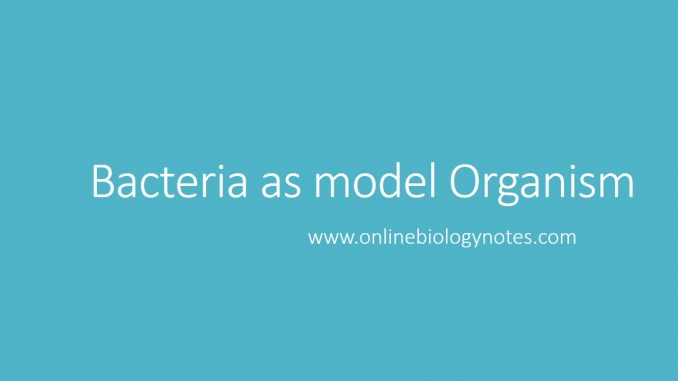
Model organism: Bacteria as model organism
Model organism:
- Model organisms are those organisms which are extensively studied to understand a specific phenomenon, expecting that the knowledge gained can be applied to other species as well.
- The model organisms are studied as an example for other species and/or biological phenomena that are more difficult to study directly.
- Models organisms are in vivo model for research purpose and consists of different non-human species because human experimentation is unfeasible and unethical for experiment.
- Some of the common model organisms are;
- E. coli– used as model for bacterial genetics and metabolism
- Saccharomyces cerevisiae (Yeast): used as model for cell and molecular biology
- Dorsophila: used as model for developmental biology
- Zebra fish: used as model for embryonic development
Bacteria as model organism in genetic, molecular and cell biology:
- For selecting any organism as model, different criteria have been looked such as size of organism, generation time, genetic composition, accessibility to genetic manipulation, conservation of mechanism as well as economic benefits.
- Some of the requirement criteria fulfilled by bacteria for model organism are;
1. Simple structure:
- Bacterial is prokaryotic and its cell is simple, so it is easy to understand the fundamental aspects of biochemistry and genetic
- E. coli is the most common model organism. It was one of the first organisms for which genetic techniques such as transformation has been developed.
2. Genetic model:
- E. coli genome has been fully sequenced and studied.
- The genome of E. coli which is approximately 4.6 million base pairs and encodes about 4000 different proteins.
- Bacteria ( E. coli) can be genetically manipulated easily
- E. coli is naturally competent, transformation process is not complicated
3. Experimental model:
- Bacterial cell is easy to manipulate and culture in minimal nutritional requirement
- Bacteria is a single cell organism, so it is cheap and easy to cultivate or mass production.
4. Short generation time
- Bacteria has very short generation time compared to other organisms.
- Usually bacteria (E.coli) form colonies containing as many as 108cells within 24 hours
- Selection of genetic variants of an E. coli strain such as mutant E. coli that are resistant to an antibiotic is easy and rapid
5. Non-pathogenic:
- Mostly E. coli are harmless
- They are the normal flora of human digestive tract.
- They poses less or no threat to researches or public
6. Used in biotechnology and microbiology:
- E. coli is a host organism for bacteriophage, which have been used for genetic recombination or recombinant DNA technology.
- E. coli can survive is varied environmental condition:
- It is suitable to grow coli is laboratory setting.
7. Plasmid DNA:
- Plasmid is an extra chromosomal double stranded circular DNA
- It is very important biological tool used in genetic engineering as transfer vector.
- Some bacteria contains plasmid DNA, while in other bacteria plasmid can be transfer. Genetic manipulation is comparatively easy in bacteria.
Examples of bacteria used as model organism in biological sciences are:
- E. coli: used in molecular genetics.
- Bacillus subtilis: used in bacterial genetics and metabolism
- Caulobacter crescentus: used to study cellular differentiation.
- Mycoplasma genitalium: a minimal organism.
- Synechocystis (Cyanobacteria): used in photosynthesis research.
- Pseudomonas fluorescens: used in bacterial genetics
- Azotobacter vinelandii: used in nitrogen fixation research.
- Streptomyces coelicolor: used to produce many clinically useful antibiotics.
